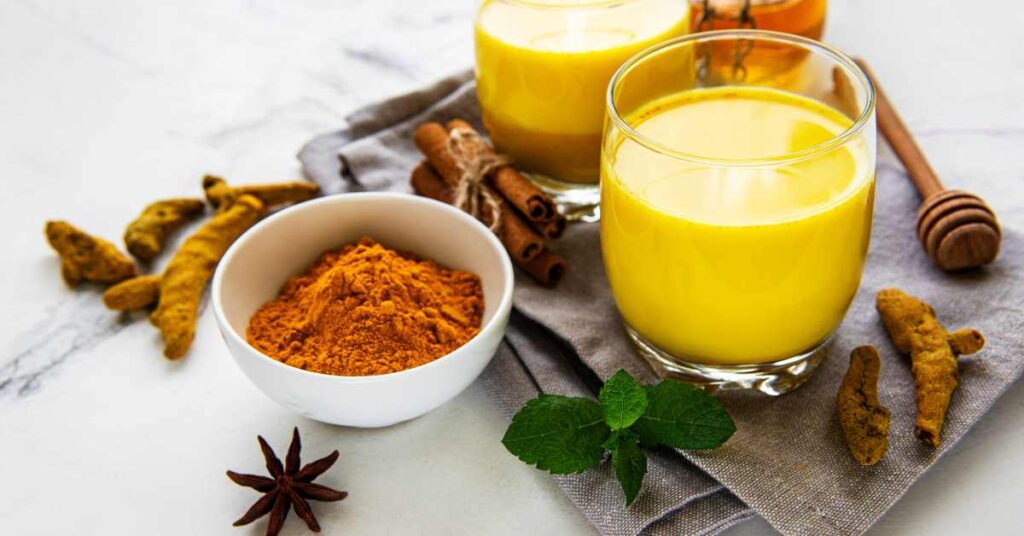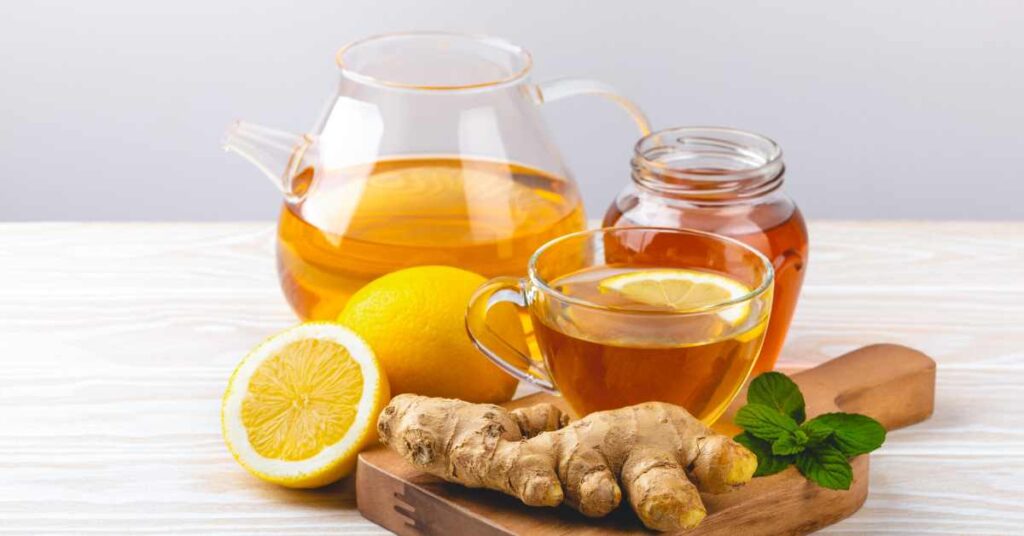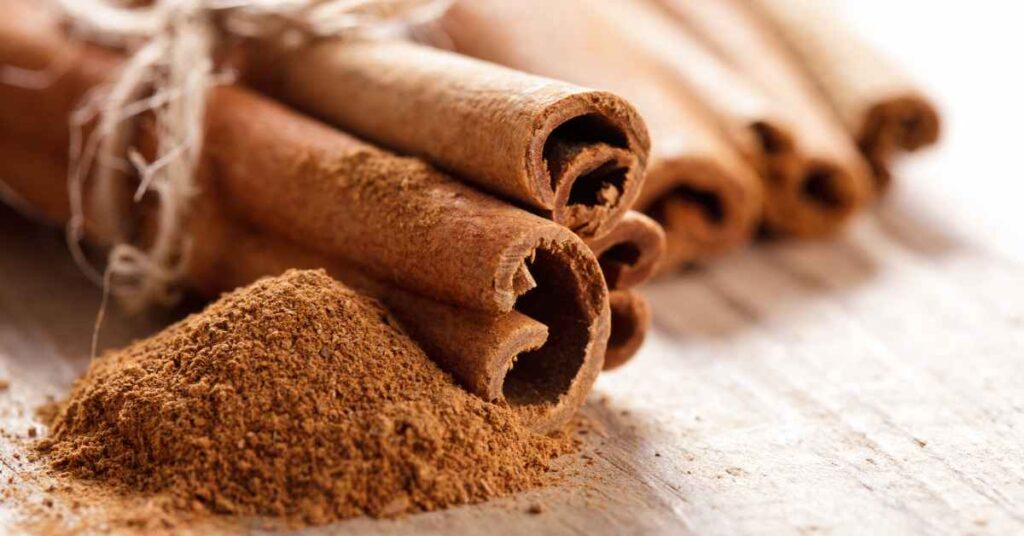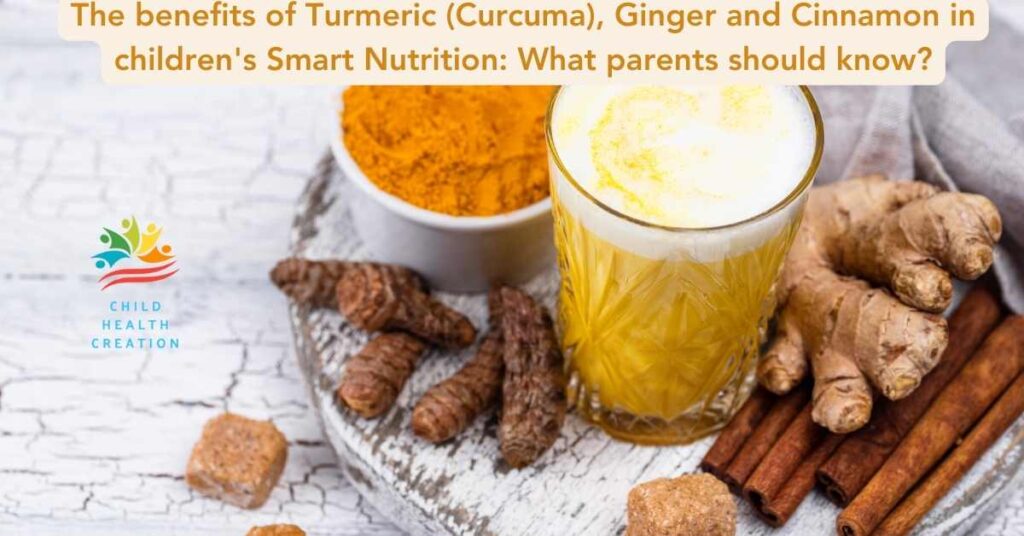Table of Contents
The benefits of Turmeric (Curcuma), Ginger and Cinnamon in children’s Smart Nutrition: What parents should know?
Introduction
“Smart nutrition” refers to an approach to nutrition that involves making informed and intelligent choices about what and how we eat. It involves considering the nutritional value of foods, understanding individual dietary needs, and making choices that contribute to overall health and well-being. Smart nutrition incorporates elements of science, balance, and mindfulness in dietary decisions.
In this article, you will read the most recent scientific approaches to the impacts of spices on children’s health and well-being. Also, you will find practical tools for improving the health conditions of your baby by correcting his or her daily diet.
Turmeric, ginger, and cinnamon are popular spices that have been used for centuries, not only for their culinary appeal but also for their potential health benefits. When incorporated into a child’s diet in appropriate amounts, these spices can contribute to their overall well-being. However, it’s important for parents to be aware of certain considerations. That is why the question becomes especially relevant: at what age can children be given cinnamon, and what healthy dishes can be used to diversify the children’s menu?
Turmeric
Useful properties: This Indian spice is in the form of yellow powder. It has many beneficial properties and is recommended for use by adults and children.

Turmeric contains curcumin, a compound with potent anti-inflammatory and antioxidant properties that relieves inflammation, helps fight infection, protects cells from damage and accelerates tissue regeneration. In the human body, this substance:
- improves the functioning of the nervous system, relieves inflammation, helps cope with stress, relieves headaches and toothaches, improves the condition of colds, and has an expectorant effect.
- It can be used to accelerate wound healing by eliminating inflammatory processes and helping get rid of acne.
- It can be beneficial for conditions like asthma or inflammatory bowel disease.
- Immune system support: The antioxidants in turmeric may contribute to a healthy immune system, helping children ward off infections.
- Curcumin improves appetite, stimulates the production of digestive juices, normalizes the functioning of the gastrointestinal tract and intestinal microflora, and eliminates bloating, flatulence, and heaviness in the abdomen.
- Turmeric can also be beneficial for children because it contains many vitamins, microelements, and other biologically active substances: iodine, iron, potassium, phosphorus, choline, dietary fibres, saccharides, and essential oils.
All these substances are essential for children’s healthy growth.
Therefore, it is recommended that this spice be included in children’s diets.
Precaution: While turmeric is generally safe when used in moderate amounts in cooking, excessive intake may lead to gastrointestinal issues and allergic reactions in the body. It’s always a good idea to introduce any new ingredient into the baby’s diet carefully and gradually and monitor for any adverse reactions.
Dosage of turmeric in children’s nutrition:
The appropriate dosage of turmeric for children can vary depending on factors such as the child’s age, weight, and overall health. Turmeric contains a compound called curcumin, which has potential health benefits but can also cause gastrointestinal issues in high doses. It’s essential to introduce turmeric gradually and in moderation.
Here are some general guidelines for incorporating turmeric into children’s nutrition:
Turmeric in Cooking:
Begin by adding a small amount of turmeric powder to your child’s meals, such as in soups, stews, rice dishes, or smoothies.
Start with a pinch or 1/8 teaspoon, and gradually increase the amount based on your child’s acceptance and tolerance.
Golden Milk: Golden milk is a popular beverage that combines turmeric with other ingredients like milk and honey. It can be a tasty and nutritious way to introduce turmeric to children. Start with a small amount, such as 1/4 teaspoon of turmeric, and adjust according to taste preferences.
Turmeric Supplements: If you are considering turmeric supplements for children, it’s crucial to consult with a healthcare professional before doing so. A healthcare provider can provide personalised recommendations based on the child’s health status.
Monitor for adverse reactions: Keep an eye on your child for any adverse reactions. Some children may have sensitivities or allergies to spices. If you notice any gastrointestinal discomfort or allergic reactions, reduce the amount of turmeric or discontinue use.
It’s crucial to emphasise that while turmeric can offer potential health benefits, more research is needed to determine optimal dosages, especially for specific health conditions in children. Always consult with health professionals before making any changes to a child’s diet or introducing new supplements, especially if the child has existing health conditions. Incorporating turmeric into a child’s diet can be a flavorful and nutritious addition. It is essential to do so mindfully and in consultation with healthcare providers. Learn more about our services at ChildHealthCreation.com.
Ginger
Digestive aid: Ginger has been used traditionally to alleviate digestive discomfort, including nausea and indigestion. It can be particularly helpful for children experiencing motion sickness.
Anti-nausea properties: Ginger may help reduce nausea, making it a useful remedy for children prone to motion sickness or nausea related to illness.

How to use ginger as anti-nausea properties in children, age, and dosage?
Ginger, for its anti-nausea properties in children, can be used in various forms, and it’s important to consider the child’s age and individual preferences. Here are some general guidelines:
1. Age-Appropriate Forms:
Young Children: For younger children who may have difficulty with strong flavours, you can introduce ginger in mild forms, such as ginger tea made with a small piece of fresh ginger or ginger candies.
Older Children: Older children may be more open to different forms, including adding grated ginger to foods or beverages or consuming ginger ale with real ginger.
2. Dosage:
Fresh Ginger: A common recommendation is to start with a small amount of fresh ginger, such as 1/4 to 1/2 teaspoon of grated ginger, and gradually increase as needed. You can add this to smoothies, soups, or other dishes.
Ginger Tea: A mild ginger tea can be made by steeping a small piece of fresh ginger in hot water. Start with a weak tea, and you can sweeten it slightly if needed. Begin with small amounts (e.g., 1-2 ounces) for younger children and adjust based on their response.
Commercial Ginger Products: If using ginger candies, cookies, or ginger ale with real ginger, follow the recommended dosage on the product packaging. Ensure that the product is suitable for children.
3. Frequency:
Acute Nausea: If a child is experiencing acute nausea (e.g., due to motion sickness or illness), ginger can be administered as needed. However, it’s crucial not to exceed recommended dosages.
Regular Use: If using ginger regularly for its potential preventive benefits, such as preventing motion sickness during car rides, it’s advisable to consult with a healthcare professional for guidance on an appropriate frequency.
4. Caution:
Allergies and Sensitivities: Be aware of any allergies or sensitivities your child may have. Introduce ginger gradually and monitor for any adverse reactions.
Consultation with Healthcare Provider: Before using ginger for medicinal purposes, especially if your child has chronic or severe nausea, it’s advisable to consult with a healthcare provider. They can provide personalized advice based on the child’s health status.
5. Variety of Applications:
Smoothies: Blend a small amount of fresh ginger into fruit smoothies.
Soups: Add grated ginger to mild soups or broths.
Baked Goods: Incorporate ginger into baked goods like muffins or cookies.
Ginger Ale: Choose ginger ale with real ginger or make your own with carbonated water and a small amount of ginger syrup.
Always pay attention to your child’s response and adjust the dosage accordingly. If nausea persists or worsens, consult with a healthcare professional for further evaluation and guidance.
Precaution: Excessive ginger intake may cause heartburn or stomach upset in some individuals. Parents should be mindful of the quantity used in cooking or when giving ginger-infused products to children.
Cinnamon
Cinnamon is an aromatic spice obtained from the dried bark of the cinnamon tree, an evergreen plant in the laurel family. Its age goes back several thousand years, it was found in the pyramids of the Egyptian pharaohs. Cinnamon is an aromatic spice loved by many. It is added to many dishes – porridge, casseroles, baked goods and various drinks. Cinnamon can perfectly diversify the usual, everyday menu, making it brighter and richer – including for children.

It is very useful to include this spice in your menu because it contains many active components:
- Vitamins A, B9, C, E, K, PP.
- Micro- and macroelements – zinc, selenium, copper, phosphorus, potassium, calcium, sodium.
- Mono- and disaccharides.
- Vegetable fiber.
- Protein.
Useful properties of the spice:
- Cinnamon saturates the children’s body with vitamins and minerals, prevents vitamin deficiency, strengthens the cardiovascular system, and normalises hematopoiesis.
- Cinnamon improves the functioning of the digestive system, stimulates appetite, and destroys pathogens. Normalises stool and fights bloating.
- It provides full mental and physical development of the child and improves vision.
- Boosts immunity and helps fight colds. It helps with dry and wet coughs and improves the condition of the respiratory organs.
- Cinnamon contains antioxidants that may contribute to overall health and well-being.
Blood sugar regulation: Cinnamon may help regulate blood sugar levels, which can be beneficial for children, especially those with insulin resistance or at risk of developing type 2 diabetes.
Precaution: Some children may be allergic to cinnamon, so it’s advisable to introduce it cautiously. Additionally, cassia cinnamon contains coumarin, which can be harmful in large amounts. Ceylon cinnamon is a safer option for regular consumption.
Peculiarities of introduction into the children’s diet:
At what age should a child be given cinnamon? It must be considered that this spice is especially useful for children of primary school age. It effectively fights chronic fatigue, improves brain activity and memory, and improves mood. Cinnamon is a product that can be given to children from an early age because its benefits have been scientifically proven.
At what age can a baby be “introduced” to aromatic spices? This question interests many mothers who are trying to diversify their children’s menus. Children can have healthy cinnamon at 1 year of age only when the parents are sure that the child does not have an allergic reaction to the spice.
Many paediatricians recommend feeding the baby dishes with the spice only after reaching 2-3 years. In any case, be sure to adhere to the basic rules for introducing complementary foods: the spice is introduced into the child’s diet for 1-6 days; the introduction of spices begins with a small pinch; the basic rule of complementary feeding is that only one new product is introduced into the children’s diet; children under 3 years old are allowed to consume a small pinch of cinnamon 1-2 times a week; children over 3 years old can eat dishes with spices 3-4 times during the week.
For children’s menus, it is best to use natural cinnamon sticks. They have a pleasant taste and aroma, a shelf life of up to 12 months, and do not contain any synthetic additives. When using ground cinnamon, it is best to choose hermetically sealed spices and avoid buying spices by weight.
In conclusion, Cinnamon is an aromatic spice that is beneficial for the digestive and immune systems. The fragrant spice must be present in the diet of a child over 2 years old – it effectively fights coughs and colds, stimulates appetite, and improves brain activity.
Conclusion
Important Considerations for Parents – moderation is key:
- While all these spices offer health benefits, moderation is crucial. Excessive intake of any food, even those with health benefits, may have negative consequences.
- Individual differences: Children’s responses to these spices can vary. Some may love the flavours, while others may be more sensitive. Pay attention to your child’s preferences and any potential adverse reactions.
- Consult with healthcare professionals: Before making significant changes to a child’s diet, especially if they have underlying health conditions or allergies, it’s advisable to consult with healthcare professionals or registered healthcare coaches and dietitians.
Incorporating Curcuma, Ginger, Cinnamon, and other spices into everyday meals can be a flavorful and healthy way to enhance a child’s nutrition. It is very useful to include these spices in the menu for your baby because they contain many active components that make a positive impact on the creation of a child’s healthy body and brain. It is essential to do so mindfully and in consultation with healthcare providers if there are any concerns.
If you found this exploration of smart nutrition helpful, consider sharing it with friends and family. Your comments are valuable, and if you’re interested in professional child health creation services, learn more via this link.





